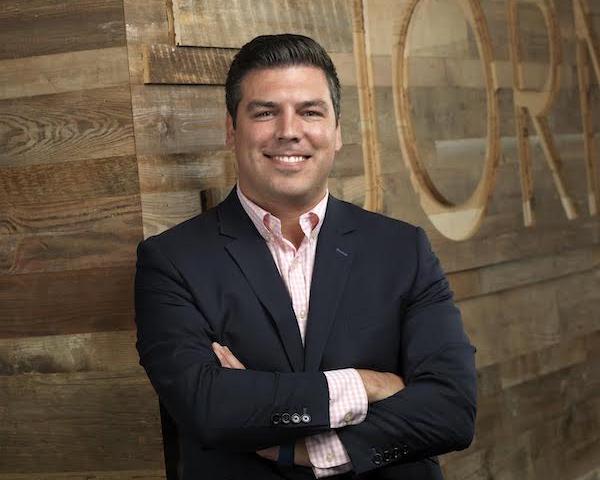Tech That Helps With Diabetic Ulcers
A high-tech boot, together with a mobile app and the cloud, provide a breakthrough for diabetics who suffer from foot ulcerations.

A high-tech boot, together with a mobile app and the cloud, provide a breakthrough for diabetics who suffer from foot ulcerations.

Get Involved
Our authors are what set Insurance Thought Leadership apart.
|
Partner with us
We’d love to talk to you about how we can improve your marketing ROI.
|
Know who your prospects and customers are, understand when they are shopping and be ready to meet them in the market.

Get Involved
Our authors are what set Insurance Thought Leadership apart.
|
Partner with us
We’d love to talk to you about how we can improve your marketing ROI.
|

Jeff Piotrowski is market leader, insurance, at Jornaya.
The line between professional and personal lives continues to blur, and a focus on employee well-being can let companies stand out.

Get Involved
Our authors are what set Insurance Thought Leadership apart.
|
Partner with us
We’d love to talk to you about how we can improve your marketing ROI.
|
One of the best tools for fraud prevention is to let employees know that false claims will not be tolerated and that penalties are stiff.

Workers' compensation fraud creates a financial and administrative burden for employers, while increasing hardship for injured workers with legitimate claims. The early identification of potential fraudulent cases and quick action by workers’ compensation third party administrators can help make sure workers’ compensation programs run as efficiently as possible in providing needed help for injured workers.
The following are some best practices employers can implement to reduce fraud, as well as guidance on what to do if a claim is “not quite right”:
Identify Questionable Claims
Here are some of the “red flags” that may help identify fraudulent claims:
Follow the Process
Even if an employer suspects a claim could be fraudulent, the employer must still follow the process to ensure the claim is submitted appropriately and the worker obtains medical treatment.
See also: Real or Fake? Finding Workers’ Comp Fraud
Investigate Promptly
Once a potential fraudulent claim is identified, it is imperative that investigations are initiated promptly. Investigations should be thorough, impartial and preventative. Using an outside party that specializes in workers’ compensation fraud investigation will ensure that the case is handled in accordance with all regulations and will hold up in court if there is a trial. Remember, only a court of law can determine fraud – not the examiner or the employer. These investigations can include:
Upon the conclusion of the investigation, any relevant findings and evidence should be presented to the district attorney’s office as well as the Department of Insurance.
Increase Awareness
One of the best tools for fraud prevention is to let employees know that false claims will not be tolerated and that there are stiff penalties. It also helps to provide employees with easy ways to report any potential fraud that they see.
One recent example of identifying, investigating and prosecuting a fraudulent claim was in the conviction of a school bus driver in San Mateo County in California in July. The claims examiner identified numerous inconsistencies in the medical reports versus the statements provided by the employee. There were alleged migraines and double vision, but tests did not support these symptoms, and it appeared that they were exaggerated.
Investigations were initiated, and the employee was observed participating in activities that were not consistent with any claimed injury. The investigative evidence was forwarded to the San Mateo County district attorney’s office, which obtained a conviction; the defendant was ordered to serve 60 days in the county jail and pay restitution of $60,000 to his employer.
See also: Workers’ Comp Issues to Watch in 2019
Organizations must implement a comprehensive strategy to curb fraud. Vigilant fraud prevention programs and investigative efforts can save a company hundreds of thousands of dollars by preventing the filing of fraudulent claims and prosecuting those who take advantage of the system.
Get Involved
Our authors are what set Insurance Thought Leadership apart.
|
Partner with us
We’d love to talk to you about how we can improve your marketing ROI.
|

Stacey Gunn, assistant vice president, is responsible for leading Keenan’s SIU/Fraud Unit, training and development and vendor management. She has more than 20 years of experience and is certified by the Insurance Educational Association.

After witnessing the Cal football team's disheartening loss to Oregon State on Saturday, I spent an hour having a beer (okay, two) at Pappy's in the heart of Berkeley, decompressing... and thinking about what the busy sports bar had to say about insurance.
I didn't intend to ponder insurance, but I guess watching SMU complete its smackdown of Temple on the TV screens didn't exactly absorb all my attention, and my somber mood probably made me more likely to notice two glitches that reminded me of inefficiencies that still plague insurance, despite all the investments in technology and attempts to reinvent processes from the viewpoint of the customer.
The big glitch occurred when, at the height of the post-game frenzy, there was a shift change behind the bar. One bartender kept serving drinks, but all the others just focused on closing out tabs and ignored all the customers stacked up several deep, trying to catch the attention of someone—anyone—behind the bar to place an order.
During the shift change, the bar-backs came out to clean up and replenish supplies, which was surely necessary but which amplified the frustration among customers. These assistants can't serve drinks, but how is a customer supposed to tell the difference between a bartender and a bar-back? From the standpoint of the customers jostling for attention, the bar looked like it had twice as many bartenders as it had had minutes before, yet almost nobody could get a drink.
If the shift change had come just half an hour later, it could have gone smoothly, because the crowd had thinned out so much by then. But the change came hard on 4, not 4:30. Pappy's management likely didn't notice how many people walked out the door in frustration after giving up on getting a drink, or realize how many will decide next time that they should try one of the many bars just down the street. After all, the place did a booming business among Cal fans drowning their sorrows. But a tiny change in process would have led to more business Saturday and more repeat business from happy customers on future weekends.
Yes, delivering an insurance policy is far more complicated than sliding a Sierra Nevada across the bar, but I'd bet that, off the top of your head, you can think of several tweaks in insurance processes that would remove frustrations for customers. We're making progress as an industry, but, given all the paper we still shuffle around, insurance remains a target-rich environment for those trying to kill inefficiency, and many tweaks are as simple as moving a shift change back a half-hour.
My second observation reinforces the first. The Pappy's bar was a machine when it came to churning out pints and pitchers of beer and at least three drinks—Moscow Mules, Jack and Cokes and Margaritas. (Man, people drank a lot of Moscow Mules, so many that Pappy's ran out of copper mugs.) But woe unto you if you ordered something out of the ordinary, like a Manhattan cocktail. The bartenders were pros and were running around so fast they were sweating, but an unusual order threw them completely out of rhythm.
The vast majority of insurance policies have to have a fair amount of complexity to them, but not every piece of a policy or every process needs to be such a one-off, and, the more we can turn into the equivalent of a Jack and Coke, the more efficient we can be.
Have a great week. And Go, Bears.
Paul Carroll
Editor-in-Chief
Get Involved
Our authors are what set Insurance Thought Leadership apart.
|
Partner with us
We’d love to talk to you about how we can improve your marketing ROI.
|

Paul Carroll is the editor-in-chief of Insurance Thought Leadership.
He is also co-author of A Brief History of a Perfect Future: Inventing the Future We Can Proudly Leave Our Kids by 2050 and Billion Dollar Lessons: What You Can Learn From the Most Inexcusable Business Failures of the Last 25 Years and the author of a best-seller on IBM, published in 1993.
Carroll spent 17 years at the Wall Street Journal as an editor and reporter; he was nominated twice for the Pulitzer Prize. He later was a finalist for a National Magazine Award.
Traditional metrics, such as the number of cases per adjuster, may be losing their importance. Metrics should evolve.

The adage says, "What gets measured gets managed." What does that mean for workers’ compensation? What can we measure to truly improve outcomes for everyone in the workers’ compensation system, from injured workers, to employers, to insurers and others? Are we measuring the most important metrics, or are we as an industry spending too much time measuring less relevant issues and excluding those that can have a real impact? How can we drive optimal outcomes by adjusting what we measure and the analytics we use to measure success? Finally, what should we measure as the industry moves forward? There is certainly no shortage of data in the workers’ compensation system, but what we do with it, how we measure it and, most importantly, how we apply it are key. Four prominent industry thought leaders joined us to discuss this important issue during our most recent Out Front Ideas webinar, which also served as the opening keynote session for the 74th annual Workers’ Compensation Educational Conference in Orlando:
Our speakers did not necessarily agree on which specific metrics are the most important to measure. But they were unanimous on what they considered the most important element of any program – treating injured workers well and getting them back to health and work as quickly as possible. Anything measured should be considered a tool to accomplish that in the most caring and efficient ways possible. Process Versus Outcome Measurements It is easy to get absorbed in our processes and to overlook the most important thing – helping the injured worker. The definition of "success" may differ for an adjuster, the employer and the medical provider. Collectively, we need to be creating measurements that will ensure a focus on providing the best outcome for the injured worker. Defining success and deciding what to measure is not a black-and-white issue in workers’ compensation. As one speaker said, “It’s not as if we are counting widgets; these are individuals, all with different issues and backgrounds.” Processes and outcomes must go hand in hand. While optimal outcomes are the goal, the processes used to get there are important. Measuring each, to a certain extent, is important. For example, measuring the timeliness of first reports of injury is valuable if it helps a large number of injured workers. Commonly Used Metrics Three-point contact, adjuster caseloads and the speed of communicating with the injured worker all are metrics that are, or have been, extensively measured. But are these still relevant? Does success for these measurements lead to better outcomes, or should they evolve? There is no definitive answer except that measurements are important if they ultimately lead to better outcomes. For example, two of our speakers disagreed on the importance of the adjuster orally communicating with the injured worker within the first 24 hours. One believed it is absolutely critical to the employee’s experience and the outcome of the injury to speak with the adjuster quickly because the contact shows that the employer cares. Also, injured employees have a tendency to say things that they might not write in an email or text, and they are more likely to remember events of the incident closer to the timing of it. However, another panelist viewed 24-hour contact as an “age old requirement” that does not fit with the adoption of mobile technology. In addition to possible logistical problems, such as being unable to contact the injured worker as he is getting medical attention, there is little, if any, information to share with him at that early point. Allowing metrics to evolve with advancing technology is important, the speakers explained. For example, the first communication with the injured worker (whenever it occurs) may be a very different conversation than it was just a short time ago. Some employers can now view employer video footage within hours of a claim being reported. That means the first conversation with the injured worker does not need to focus on discovering exactly what happened, because that is already known. See also: Social Determinants of Workforce Health The number of cases per adjuster is another metric that may be losing its importance. Despite some calls for an industry standard, many feel it is less relevant than it was several years ago. Technology has made medical-only claims much easier to handle. Also, factors such as the skill level of the adjuster and the complexity of each claim should dictate the number of cases each adjuster handles. Measuring savings from managed care may be less significant than it once was. Savings from bill review, and looking at a 12-month rolling average, do not show how well an organization is doing as opposed to a comparison over time or to another benchmark. Some employers are investing heavily in onsite clinics to make sure injured workers get quality medical care as soon as possible. One panelist said the most important metrics to measure are those that focus on these core factors:
Using Metrics Appropriately A criticism of the workers’ compensation system is the inability to make certain measurements meaningful, collecting all sorts of data but not using that information to improve. One panelist pointed out that, while the industry extensively measures first report of injury, it does not measure or adequately discuss the small percentage of disputed claims that actually go to trial. They noted that the number of settlements has gone up dramatically, while the number of awards is decreasing. While that may indicate improvements in the workers’ compensation system, the information is not being used to improve processes. According to the panelists, sharing data is one of the biggest opportunities to improve the system. Safety information and workers’ compensation data are being gathered in the same building but not shared among the departments collecting them. Breaking down the silos within the regulatory side of the industry has also been a major focus as this can result in more aggregate information available to all stakeholders. Regulators are also providing more data to the industry, which can allow employers and injured workers to explore trends and see types of injuries by county, injury type and industry. Understanding what is being measured, and relating it back to how the system functions, can improve performance and outcomes. Finally, the panel explained that maintaining actuarial predictability is very important for employers. If you are making significant changes to your program, be sure to discuss these with the actuaries so they can adjust their modeling. Employers should meet with actuaries frequently to monitor trends that are affecting their program. It is important to show actuaries how all the metrics work together to see the whole story, rather than looking at any one metric in isolation. See also: Bridging Health and Productivity at Work The Future The industry will need to learn to trust the metrics more, the speakers said. Sometimes the data that is captured through predictive analytics and other new tools contradicts what we think is correct. But it is time for stakeholders to rely on the technology, rather than what their guts are telling them. At the same time, it is crucial to make sure the customer is happy, regardless of what the measurements show. Measurements do not matter if the injured worker has a bad experience. There is no single measure that will guarantee success. The metrics can lead to positive outcomes as long as they are viewed as one factor in the overall injury management program and organizations are willing to evolve and change with technology and the experiences of injured workers. At the end of the day, it is how well we care for injured workers that is the most important thing. You can view the complete presentation at https://www.outfrontideas.com/archives/.
Get Involved
Our authors are what set Insurance Thought Leadership apart.
|
Partner with us
We’d love to talk to you about how we can improve your marketing ROI.
|

Kimberly George is a senior vice president, senior healthcare adviser at Sedgwick. She will explore and work to improve Sedgwick’s understanding of how healthcare reform affects its business models and product and service offerings.

Mark Walls is the vice president, client engagement, at Safety National.
He is also the founder of the Work Comp Analysis Group on LinkedIn, which is the largest discussion community dedicated to workers' compensation issues.
The global approach to cybersecurity has remained the same for decades: Respond and recover. New technology can prevent attacks.

Get Involved
Our authors are what set Insurance Thought Leadership apart.
|
Partner with us
We’d love to talk to you about how we can improve your marketing ROI.
|
Augmented automated underwriting, or AAU for short, is destined to become one of the key talking points in insurtech.

Get Involved
Our authors are what set Insurance Thought Leadership apart.
|
Partner with us
We’d love to talk to you about how we can improve your marketing ROI.
|
Holistic healthcare providers see technology as depersonalizing. In fact, tech is at the heart of moving from diagnosis to prevention.

Get Involved
Our authors are what set Insurance Thought Leadership apart.
|
Partner with us
We’d love to talk to you about how we can improve your marketing ROI.
|
Customers need constant reassurance that things will be explained, the next steps will be clear and the company is there for them.

Get Involved
Our authors are what set Insurance Thought Leadership apart.
|
Partner with us
We’d love to talk to you about how we can improve your marketing ROI.
|